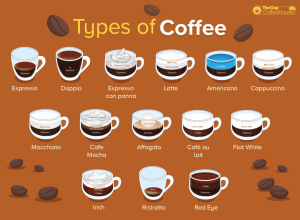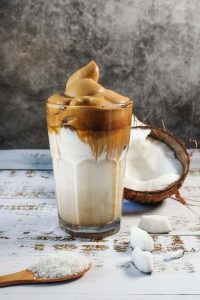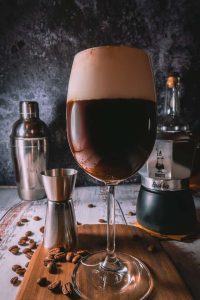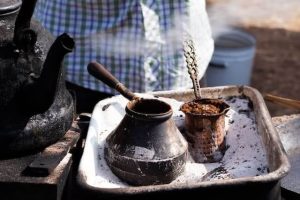20 Different Types of Coffee Drinks – The Ultimate Guide: In the vast and aromatic world of coffee, enthusiasts and casual sippers embark on a delightful journey through diverse coffee beverages. From the classic and comforting to the exotic and adventurous, the realm of coffee is rich with choices that cater to every palate. This comprehensive guide unveils the fascinating tapestry of 20 different types of coffee drinks, each offering a unique blend of tastes, aromas, and cultural influences.
Whether you’re a seasoned coffee connoisseur or just beginning to explore the vast possibilities within a coffee cup, this guide is your passport to understanding, appreciating, and savoring the nuances of various coffee creations. From the iconic Espresso and Cappuccino to the trendy Flat White and decadent Affogato, each entry in this guide is a flavorful chapter in the captivating story of coffee.
Join us as we traverse the coffee landscape, exploring the origins, preparation methods, and distinctive characteristics that define each type of coffee drink. Whether you seek a bold and intense experience or a velvety and sweet indulgence, this guide is your companion to discovering the endless possibilities that make coffee an art form, a cultural tradition, and a source of pure delight.
So, grab your favorite mug, and let’s embark on a journey through the enticing world of coffee craftsmanship.
20 Different Types of Coffee Drinks:

Here, I want to describe the detailed information about all the mentioned coffee types. Let’s explore one by one.

1. Decaf
“Decaf” is a term used as a shorthand for “decaffeinated.” It refers to coffee or other beverages that have undergone a process to remove or significantly reduce their caffeine content. Decaffeinated coffee is a popular choice for individuals who enjoy the taste and experience of coffee but want to limit their caffeine intake due to sensitivity to caffeine or personal preference.
The decaffeination process typically takes place before the coffee beans are roasted. Various methods are employed to extract caffeine while attempting to retain the flavor compounds that contribute to the characteristic taste of coffee. It’s important to note that decaffeinated coffee is not entirely caffeine-free. While most of the caffeine is removed, trace amounts may remain.
Decaf coffee allows individuals to enjoy the ritual and flavor of coffee without the stimulating effects of caffeine. It’s a popular choice for those who want to enjoy coffee later in the day or for individuals sensitive to caffeine’s effects on sleep, heart rate, or other factors.
2. Espresso

Espresso is a strong coffee beverage made in Italy and has become a worldwide cornerstone of coffee culture. It is made by forcing warm water through finely-ground coffee under high pressure, producing a small but potent shot of concentrated coffee.
Brewing Process:
Finely ground coffee beans are firmly packed into a portafilter, a small, perforated metal basket to brew espresso. Warm water is then forced through the coffee grounds under pressure, typically between 9 and 10 bars (atmospheres), quickly extracting the flavors and aromatic compounds. The result is a highly concentrated coffee shot known as espresso.
Characteristics:
- Size: An espresso shot is typically around 1 ounce (30 milliliters).
- Crema: A layer of crema, a golden-brown froth, forms on top of a well-pulled espresso. This combines coffee oils and carbon dioxide produced during the brewing process.
- Flavor Profile: Espresso has a rich and intense flavor, with a balance of sweetness, acidity, and bitterness. The concentrated nature of espresso allows for the nuanced expression of the coffee bean’s characteristics.
Popular Espresso-Based Drinks:
- Americano: Diluted espresso with added hot water.
- Latte: Espresso by steamed milk and a small quantity of foam.
- Cappuccino: Espresso by equal parts steamed milk and foam.
- Macchiato: Espresso “stained” with a small quantity of milk.
Serving Style:
Espresso is often served in small, demitasse cups designed to capture and showcase the intensity of its flavor. It serves as the foundation for other coffee beverages and is a critical component in many coffee recipes.
Espresso’s quick preparation, bold flavor, and versatility make it a beloved choice for coffee enthusiasts and the foundation for a wide array of specialty coffee drinks.
3. Americano
The Americano is a popular coffee beverage created during World War II when American soldiers in Italy sought a coffee experience more akin to what they were accustomed to back home. To recreate a brew closer to drip coffee, they diluted espresso with hot water, giving rise to the Americano.
Brewing Process:
Americano is created by diluting a shot of espresso with warm water. The strength and flavor can be adjusted by varying the water-to-espresso ratio. The result is a coffee with a flavor profile similar to traditional drip coffee but with the concentrated essence of espresso.
Characteristics:
- Size: An Americano is typically more extensive than a standard espresso, ranging from 4 to 8 ounces (120 to 240 milliliters).
- Strength: While not as concentrated as espresso, the Americano maintains a robust flavor, combining the richness of espresso with the milder profile of drip coffee.
Serving Style:
Americano is often served in a coffee mug and can be enjoyed black or with added cream or sugar, according to personal preference. Its versatility makes it popular for those who enjoy a more in-depth coffee than a standard drip-brew.
Customizations:
- Long Black: Similar to an Americano but with the espresso poured over hot water instead of the reverse.
- Red Eye: An Americano with an added shot of espresso for extra strength.
Appeal:
The Americano’s appeal lies in its ability to offer a coffee experience that bridges the gap between the concentrated richness of espresso and the familiar, larger volume of traditional American-style coffee. It’s a go-to choice for those seeking a milder yet still robust coffee flavor.
4. Dalgona Coffee

Dalgona Coffee, a viral sensation that took the internet by storm, is a visually striking and indulgent coffee drink. From South Korea, Dalgona Coffee gained widespread popularity through social media platforms, especially during the early stages of the COVID-19 pandemic.
Ingredients:
- Instant coffee
- Sugar
- Hot water
- Milk (for serving)
Brewing Process:
- In a bowl, combine equal parts instant coffee, sugar, and hot water (typically 1 tablespoon each).
- Whip the mixture vigorously until it transforms into a thick, creamy, and velvety foam.
- Pour milk over ice into a glass.
- Spoon the whipped coffee over the milk.
Characteristics:
- Visual Appeal: Dalgona Coffee is known for its distinctive two-layer appearance, with a fluffy, whipped coffee layer on top of the milk.
- Flavor Profile: The whipped coffee layer is rich, sweet, and carries a strong coffee flavor. Mixing with the milk creates a harmonious blend of sweetness and coffee notes.
Serving Style:
Dalgona Coffee is often served in a transparent glass to showcase the layers. The whipped coffee layer is spooned or carefully poured over cold or hot milk.
Appeal:
The appeal of Dalgona Coffee extends beyond its taste – it’s a visually appealing and Instagram-worthy beverage. The act of whipping the coffee mixture to create the frothy top adds an element of fun and creativity to the coffee-making process. Dalgona Coffee became a global trend due to its simplicity, accessibility of ingredients, and the joy it brought to individuals experimenting with coffee at home.
5. Red Eye
Red Eye coffee, a “shot in the dark,” is a simple yet potent coffee that combines drip coffee with espresso. This concoction is designed to boost caffeine significantly, making it a popular choice for those seeking extra energy.
Brewing Process:
- Brew a cup of regular drip coffee.
- Add a shot of espresso to the brewed coffee.
- Stir to combine the two.
Characteristics:
- Caffeine Content: Adding espresso to regular coffee significantly increases the caffeine content of the beverage, making it a solid and energizing drink.
- Flavor Profile: Red Eye coffee maintains the flavor characteristics of both drip coffee and espresso. It often has a bold and robust taste.
Serving Style:
Red Eye coffee is typically served in a mug or coffee cup. The visual appeal is similar to a regular cup of coffee, but the intensified caffeine kick sets it apart.
Variations:
- Black Eye: Similar to a Red Eye but with two espresso shots.
- Dead Eye: An even more robust version featuring three shots of espresso.
Appeal:
The primary appeal of Red Eye coffee lies in its ability to deliver a powerful caffeine boost. It’s a go-to choice for those who crave a robust coffee flavor coupled with the concentrated punch of espresso. Red Eye coffee is especially popular among individuals who need an extra kickstart to their day or those tackling long hours and needing sustained alertness.
6. Latte

A latte, short for caffè latte in Italian, is a popular espresso-based coffee drink known for its rich and creamy texture. The word “latte” means milk in Italian, and the drink is aptly named due to its significant amount of steamed milk.
Brewing Process:
- Pull a shot of espresso (around 1 ounce).
- Steam and froth milk until it reaches a velvety and creamy consistency.
- Pour the steamed milk over the espresso, holding back the foam with a spoon.
- Spoon the remaining foam over the top to create a layered effect.
Characteristics:
- Coffee-to-Milk Ratio: A typical latte has a higher ratio of steamed milk to espresso, resulting in a milder coffee flavor than a cappuccino.
- Texture: The steamed milk contributes to a smooth and creamy texture, and the froth layer adds light and airy quality.
- Presentation: Lattes are often served in tall glasses or ceramic cups, showcasing the layered structure with the rich, dark espresso at the bottom and the creamy-frothed milk on top.
Customizations:
- Flavor Syrups: Lattes can be flavored with various syrups such as vanilla, caramel, hazelnut, or others to add sweetness and flavor profiles.
- Iced Latte: Served over ice for a refreshing twist.
- Chai Latte: Replace the espresso with chai tea, creating a spiced version.
Appeal:
The latte’s appeal lies in its harmonious balance of espresso and milk, creating a comforting and indulgent coffee experience. Its versatility allows for personalization with different milk types, flavorings, and serving temperatures, making it a beloved choice for coffee enthusiasts seeking a creamy and satisfying beverage.
7. Cafe au Lait
Café au Lait, a French term that translates to “coffee with milk,” is a simple and classic coffee beverage that combines equal parts brewed coffee and steamed milk. This delightful concoction is favored for its straightforward preparation and balanced flavor profile.
Brewing Process:
- Brew a strong coffee using a drip coffee maker or French press.
- Heat equal milk, ensuring it is steamed but not frothed.
- Pour the brewed coffee into a cup.
- Add an equal quantity of steamed milk to the coffee.
Characteristics:
- Equal Parts: Café au Lait maintains a 1:1 ratio of coffee to steamed milk, producing a balanced and mild flavor.
- Texture: The steamed milk contributes a velvety and creamy texture to the coffee.
- Strength: While not as strong as a straight black coffee, Café au Lait is more robust than a latte due to the absence of foam and the use of brewed coffee.
Serving Style:
Café au Lait is traditionally served in a bowl or a large mug, allowing ample space for coffee and steamed milk. It can be enjoyed anytime and sets well with breakfast pastries or light snacks.
Customizations:
- Flavorings: Sweeteners, vanilla, or other flavorings can be added according to personal preference.
- Iced Café au Lait: Served over ice for a refreshing twist.
Appeal:
Café au Lait’s appeal lies in its simplicity and the perfect harmony between coffee and milk. It provides a comforting and mild coffee experience, making it an excellent choice for those who enjoy a gentler coffee flavor with the added richness of steamed milk.
8. Frappe

Frappe coffee, originating from Greece, is a refreshing and icy coffee that combines instant coffee, sugar, water, and ice. Known for its smooth and frothy texture, Frappe is popular during warm weather or when a chilled and refreshing coffee experience is desired.
Brewing Process:
- Combine instant coffee, sugar, and a small amount of water in a shaker or blender.
- Shake or blend the combination until it becomes frothy and creamy.
- Pour the frothed coffee over a glass filled with ice.
- Optionally, add milk and sweeteners to taste.
Characteristics:
- Texture: Frappe coffee is characterized by its frothy and creamy texture, achieved through vigorous shaking or blending.
- Temperature: Served over ice, Frappe is a cold and refreshing beverage, making it a popular choice in warmer climates.
- Strength: The strength of Frappe can be adjusted by varying the amount of instant coffee used in the preparation.
Serving Style:
Frappe coffee is typically served in a tall glass, often accompanied by a straw. For added flair, it can be garnished with whipped cream, cocoa powder, or other toppings.
Customizations:
- Flavorings: Additional flavorings such as vanilla or chocolate can be incorporated.
- Alcohol: Some variations include the addition of spirits like Baileys or Kahlúa for an adult twist.
Appeal:
Frappe coffee’s appeal lies in its bold coffee flavor, icy refreshment, and creamy texture. It provides a delightful alternative to hot coffee, especially in warmer weather, and has gained popularity worldwide as a favorite summer drink. The versatility of Frappe allows for creative variations and customizations to suit individual preferences.
9. Flat White
The Flat White is a coffee beverage that originated in Australia or New Zealand, and it has gained international popularity for its unique combination of strong espresso and velvety microfoam. This drink is celebrated for its balance, creamy texture, and the artful integration of espresso and steamed milk.
Brewing Process:
- Pull one or two espresso shots (around 1 to 2 ounces).
- Steam milk to create a delicate and velvety microfoam, achieving a glossy, paint-like consistency.
- Pour the steamed milk over the espresso, allowing the microfoam to settle on top.
Characteristics:
- Coffee-to-Milk Ratio: A Flat White has a higher coffee-to-milk ratio than a latte, resulting in a more robust coffee flavor.
- Microfoam: The hallmark of a Flat White is the microfoam, a finely textured, velvety foam that blends seamlessly with the espresso.
- Strength: It balances the intensity of espresso and the smoothness of steamed milk.
Serving Style:
A Flat White is classically served in a smaller cup than a latte or cappuccino to maintain the balance between espresso and milk. The velvety microfoam gives it a polished and sophisticated appearance.
Customizations:
- Size: Flat Whites are often served in various sizes, allowing for personal preference and customization.
- Flavorings: While traditionally served without flavorings, some variations may include vanilla or other syrups.
Appeal:
The Flat White’s appeal lies in its harmonious balance, providing a strong coffee flavor without the dominance of foam in a cappuccino. It appeals to those who appreciate the boldness of espresso but desire a creamier and smoother texture than a traditional macchiato or espresso shot.
10. Raf
Raf coffee, short for “Rafale,” is a luxurious and indulgent beverage originating in Ukraine. It is known for its creamy and rich composition, combining espresso, steamed milk, and honey.
Brewing Process:
- Pull one or two shots of espresso.
- Steam milk to create a velvety microfoam.
- Combine the espresso and steamed milk, ensuring a balanced coffee-to-milk ratio.
- Sweeten with honey to taste.
Characteristics:
- Texture: Raf coffee features a silky and luxurious texture, achieved through the incorporation of microfoam.
- Sweetness: Adding honey imparts a natural sweetness to the beverage, complementing the richness of the espresso and milk.
- Temperature: Raf coffee is served warm, providing a comforting and cozy experience.
Serving Style:
Raf coffee is typically served in a glass or a cup, allowing the layers of espresso, milk, and foam to be visually appreciated. The addition of honey is often stirred into the drink or drizzled on top.
Customizations:
- Flavorings: Some variations may include additional flavorings such as vanilla or cinnamon.
- Variations: Raf coffee can be prepared with variations in the amount of honey or the type of milk used.
Appeal:
Raf coffee’s appeal lies in its combination of a strong coffee base with the velvety smoothness of microfoam and the natural sweetness of honey. It is favored by those who enjoy a decadent and well-balanced coffee experience with a touch of sweetness, making it a comforting choice, especially during colder seasons.
11. Cortado

Cortado is a coffee drink created in Spain and has become popular in various coffee cultures worldwide. It is characterized by its simple yet balanced combination of espresso and a small amount of warm milk. The word “cortado” in Spanish means “cut” or “short,” indicating the reduction of acidity in the espresso by cutting it with milk.
Brewing Process:
- Pull a shot of espresso (around 1 ounce).
- Steam a small amount of milk to warm it, creating a velvety and creamy texture.
- Pour the warm milk into the espresso, “cutting” it to reduce acidity.
Characteristics:
- Coffee-to-Milk Ratio: Cortado has a nearly equal ratio of espresso to warm milk, resulting in a solid yet mellow flavor.
- Temperature: The milk is warmed rather than frothed, maintaining a smooth and creamy texture without excessive foam.
- Strength: Cortado balances the boldness of espresso and the creaminess of milk.
Serving Style:
Cortado is often aided in a small glass or cup, allowing for the appreciation of its balanced layers. The small size emphasizes the concentrated and rich nature of the drink.
Customizations:
- Size: While traditionally small, some variations may allow for size adjustments.
- Temperature: Some may prefer the milk warmer or cooler according to personal taste.
Appeal:
The appeal of Cortado lies in its simplicity and balance. It offers a coffee experience where the boldness of espresso is complemented by warm milk’s smooth and slightly sweet character. Cortado is favored by those who enjoy the intensity of espresso but desire a bit of creaminess to mellow its robustness.
12. Espresso Con Panna
Espresso Con Panna is a delightful espresso-based coffee beverage that hails from Italy. The name translates to “espresso with cream” in Italian. This simple yet indulgent drink is an espresso topped with freshly whipped cream.
Brewing Process:
- Pull a shot of espresso (around 1 ounce).
- Whip fresh cream until it reaches a thick but not too stiff consistency.
- Spoon of whipped cream on top of the espresso.
Characteristics:
- Cream Topping: The defining feature of Espresso Con Panna is the rich and velvety whipped cream topping.
- Contrast: The contrast between the espresso’s boldness and the whipped cream’s smoothness creates a harmonious and indulgent experience.
- Temperature: While the espresso is hot, the whipped cream topping adds a cool and creamy element to each sip.
Serving Style:
Espresso Con Panna is typically served in a small cup or glass, allowing for the visual appreciation of the layered espresso and cream. The whipped cream may be gently stirred into the espresso before drinking.
Customizations:
- Flavorings: Some variations may include flavored syrups or extracts in the whipped cream for added complexity.
- Chocolate Shavings: A sprinkle of chocolate shavings on top of the whipped cream is a popular variation.
Appeal:
Espresso Con Panna appeals to those who enjoy the intensity of espresso but desire a touch of luxury and sweetness. The whipped cream topping adds a velvety texture and a slightly sweet note, enhancing the coffee experience. It’s a simple yet elegant choice for coffee enthusiasts looking for a treat without excessive sweetness.
13. Irish coffee

Irish coffee is a beloved and classic cocktail-style coffee that originated in Ireland. Known for its comforting warmth and delightful combination of coffee, Irish whiskey, sugar, and a crown of whipped cream, it’s perfect for those seeking a cozy and spirited coffee experience.
Brewing Process:
- Brew a strong cup of hot coffee (about 6 ounces).
- Add a tea spoon of sugar to the coffee and stir until dissolved.
- Pour a shot of Irish whiskey (usually about 1 ½ ounces) and stir.
- Top the coffee with a layer of freshly whipped cream.
Characteristics:
- Whiskey Influence: Irish whiskey adds a robust and warming element to the coffee.
- Sweetness: The sugar enhances the overall sweetness of the drink, balancing the bitterness of the coffee.
- Creamy Crown: The whipped cream topping provides a smooth and luxurious texture.
Serving Style:
Irish coffee is usually served in a warm mug or heatproof glass. The whipped cream is gently floated on the coffee to create a visually appealing layer.
Customizations:
- Variations: Some variations may include flavored syrups or different types of whiskey.
- Garnishes: A sprinkle of nutmeg or chocolate shavings on top of the whipped cream can be added for extra flair.
Appeal:
Irish Coffee appeals to those who appreciate a warming and spirited beverage. The combination of coffee, whiskey, and whipped cream creates a harmonious mixture of flavors and textures, making it a popular choice for sipping on chilly evenings or as a comforting nightcap.
14. Cold Brew
Cold Drink coffee is a refreshing and smooth coffee beverage known for its mellow flavor and lower acidity. Unlike traditional brewing methods that use hot water, Cold Brew steeps coarsely ground coffee beans in cold water for an extended period.
Brewing Process:
- Coarsely grind coffee beans.
- Combine the coffee grounds with cold or room-temperature water at approximately 1:4 or 1:5.
- Stir the mixture to ensure even saturation.
- Let the coffee steep for an extended period, usually 12 to 24 hours.
- Strain the blend to remove the coffee grounds, leaving a concentrated Cold Brew coffee.
- Dilute the concentrate with water, milk, or an alternative to achieve the desired strength.
- Serve over ice and optionally sweeten or flavor as desired.
Characteristics:
- Smoothness: Cold Brew is known for its smooth and less acidic profile, creating a mellow and highly drinkable coffee.
- Concentration: The brewing process yields a concentrated coffee that is typically diluted before serving.
- Cold Serving: Cold Brew is served over ice, making it a refreshing and chilled beverage.
Serving Style:
Cold Brew is often served in a glass over ice, and it can be customized with milk, cream, sweeteners, or flavored syrups according to personal preference. Due to its concentrated nature, Cold Brew is versatile and can be used as a base for various coffee beverages.
Customizations:
- Milk or Cream: Adjust the level of creaminess by adding milk, cream, or a dairy-free alternative.
- Sweeteners: Customize the sweetness with sugar, simple syrup, or flavored syrups.
- Flavorings: For added complexity, experiment with flavorings such as vanilla, cinnamon, or chocolate.
Appeal:
Cold Brew coffee appeals to those who enjoy a chilled and less acidic coffee experience. Its smooth and concentrated nature makes it a favorite among coffee enthusiasts seeking a refreshing alternative, particularly during warm weather or as a pick-me-up on the go.
15. Cappuccino

Cappuccino is a classic Italian coffee beverage known for its balanced combination of espresso, steamed, and frothed milk. Recognized for its luxurious and creamy texture, a well-made cappuccino showcases the artistry of espresso preparation.
Brewing Process:
- Pull one or two espresso shots (around 1 to 2 ounces).
- Steam milk to create a velvety microfoam, maintaining a glossy and paint-like consistency.
- Pour the steamed milk over the espresso.
- Top the drink with a thick layer of frothed milk.
Characteristics:
- Coffee-to-Milk Ratio: Cappuccino traditionally has equal parts of espresso, steamed, and frothed milk.
- Temperature: The espresso is hot, and the combination of steamed and frothed milk provides a warm and comforting temperature.
- Frothed Milk: The frothed milk on top adds a light and airy touch to the drink.
Serving Style:
Cappuccino is naturally served in a small cup, showcasing the layered structure of espresso, steamed milk, and froth. The visual appeal includes the contrast between the dark espresso and the white froth.
Customizations:
- Size: While the classic cappuccino is small, variations in size are standard.
- Flavorings: Some cappuccinos may include flavored syrups for added taste.
Appeal:
Cappuccino appeals to those who appreciate a balanced and rich coffee experience. Combining strong espresso with the creamy microfoam creates a luxurious texture and a harmonious flavor profile. It’s a popular choice for those looking for a sophisticated and satisfying coffee beverage.
16. Mocha Latte
Mocha Latte, often called “Mocha,” is a delightful coffee drink that combines the rich tastes of espresso, steamed milk, and chocolate. It’s a sweet and indulgent drink that combines the robustness of coffee with the sweetness of chocolate.
Brewing Process:
- Pull one or two espresso shots (around 1 to 2 ounces).
- Steam milk to create a velvety microfoam.
- Add coffee syrup or cocoa powder to the espresso.
- Pour the steamed milk into the espresso-chocolate mixture.
- Optionally, top with whipped cream and a drizzle of chocolate syrup.
Characteristics:
- Chocolate Flavor: Adding chocolate syrup or cocoa powder imparts the coffee a sweet and chocolatey taste.
- Sweetness: Mocha Latte is sweeter than a regular latte due to its chocolate component.
- Creaminess: The steamed milk contributes to a creamy and smooth texture.
Serving Style:
Mocha Latte is typically served in a cup or glass, and the optional whipped cream and chocolate drizzle adds to its visual appeal. The whipped cream can either be stirred into the drink or left as a decadent topping.
Customizations:
- Flavorings: Variations may include different chocolate flavors, such as white chocolate or dark chocolate.
- Sweeteners: Adjust the level of sweetness with additional sugar or flavored syrups.
Appeal:
Mocha Latte appeals to those with sweet teeth who enjoy coffee and chocolate. It’s a popular choice for those seeking a comforting and indulgent beverage, offering a delightful blend of the rich and bold flavors of espresso with the sweetness of chocolate.
17. Turkish coffee

Turkish coffee is a traditional and iconic coffee preparation that dates back centuries, with roots in the Ottoman Empire. Known for its intense flavor, fine grounds, and ritualistic brewing process, Turkish Coffee is a cultural symbol and a unique coffee experience.
Brewing Process:
- Finely grind coffee beans to a powder-like consistency.
- Add finely ground coffee, water, and sugar (optional) to a special pot called a cezve.
- Stir the mixture well and place it on low heat.
- Allow the coffee to slowly heat without boiling, forming a foam on the surface.
- Pour the unfiltered coffee, grounds, and all into small cups without stirring.
- Allow the grounds to settle before sipping.
Characteristics:
- Fine Grounds: Turkish coffee uses an extra-fine grind, resulting in a sludgy sediment at the bottom of the cup.
- Foam: The brewing process produces a distinctive foam or “kaymak” on the surface.
- Strong Flavor: The coffee is bold, strong, and often served in small quantities.
Serving Style:
Turkish coffee is usually aided in small cups without handles called “fincan.” A glass of water often accompanies it to cleanse the palate between sips.
Customizations:
- Sugar: Sugar is often added during the brewing process, and the level of sweetness can be adjusted to personal preference.
- Cardamom: Some variations include a touch of cardamom for added flavor.
Appeal:
Turkish Coffee appeals to those who appreciate a strong, concentrated coffee with a unique brewing ritual. The experience goes beyond the taste, involving cultural and social aspects, making it a symbol of hospitality in Turkish tradition.
18. Macchiato

Macchiato, an Italian word that translates to “stained” or “spotted,” refers to a simple and bold coffee beverage that combines a shot of espresso with a small amount of frothed milk or foam. The result is a strong and flavorful coffee with a touch of creaminess.
Brewing Process:
- Pull one or two espresso shots (around 1 to 2 ounces).
- Add a small amount of frothed milk or foam to the top of the espresso.
Characteristics:
- Coffee-to-Milk Ratio: Macchiato has a higher ratio of coffee to milk, allowing the boldness of the espresso to shine.
- Minimal Milk: The amount of frothed milk or foam is just enough to “stain” the espresso, adding a touch of creaminess without overpowering the coffee.
- Temperature: Macchiato is typically served warm, maintaining the heat of the espresso.
Serving Style:
Macchiato is often served in a small espresso cup, showcasing the simplicity and elegance of the beverage. It can be served as is or with minimal garnishes.
Customizations:
- Flavorings: Some variations may include flavored syrups or extracts for added complexity.
- Caramel or Chocolate Drizzle: A drizzle of caramel or chocolate on top is a common variation.
Appeal:
Macchiato appeals to those who appreciate the intensity of espresso but desire a hint of creaminess. It’s a straightforward and bold coffee choice highlighting the coffee beans’ quality and the espresso extraction skill. Macchiato is favored by those who enjoy a quick and uncomplicated coffee experience.
19. Café Cubano
Café Cubano, also known as Cuban coffee or espresso, is a distinctive and robust coffee preparation that originated in Cuba. It is characterized by its sweet and robust flavor, created through a specific brewing method that involves adding sugar to the coffee grounds during the espresso extraction.
Brewing Process:
- Add finely ground dark roast coffee to the espresso machine’s portafilter.
- Sprinkle sugar (traditionally, demerara sugar) over the coffee grounds.
- Pull a shot of espresso, allowing the sugar to caramelize and mix with the coffee.
Characteristics:
- Sweetness: Adding sugar during brewing creates a naturally sweet and syrupy espresso.
- Strength: Café Cubano is known for its bold and concentrated flavor.
- Crema: The espresso should have a rich layer of crema on top, indicating a well-pulled shot.
Serving Style:
Café Cubano is traditionally served in small cups, often called “tacitas,” and is a popular choice for a quick and energizing pick-me-up.
Customizations:
- Double Shot: Many Café Cubano preparations involve pulling a double shot of espresso for added strength.
- Café Cortadito: This variation includes a small amount of warm milk to slightly mellow the intensity.
Appeal:
Café Cubano appeals to those who appreciate intense, sweet coffee flavors. The caramelization of sugar during the brewing process enhances the overall richness of the espresso, making it a favorite for those who enjoy a robust and energizing coffee experience with a touch of sweetness.
20. Caffe Crema
Caffè Crema, translated from Italian as “cream coffee,” is an espresso that originated in Italy. It is known for its lighter color, milder flavor, and larger volume than traditional espresso. Caffè Crema is often associated with Northern Italian coffee culture.
Brewing Process:
- Like espresso, Caffè Crema is brewed by forcing warm water through finely-ground coffee under high pressure.
- The critical difference lies in the extended extraction time, resulting in a more prominent, diluted coffee.
Characteristics:
- Volume: Caffè Crema has a larger volume than a regular espresso, typically ranging from 5 to 8 ounces.
- Strength: While milder than espresso, Caffè Crema is more potent and concentrated than regular drip coffee.
- Crema: A well-made Caffè Crema retains a layer of crema on top, the golden-brown froth that is a hallmark of quality espresso.
Serving Style:
Caffè Crema is served in a larger cup than espresso, allowing for a more extended and leisurely drinking experience. It is often enjoyed in black, but sugar or milk can be added according to preference.
Customizations:
- Milk: Some individuals enjoy Caffè Crema with a splash of milk or cream.
- Sugar: Sweeteners can be added to enhance the flavor if desired.
Appeal:
Caffè Crema appeals to those who enjoy a strong coffee experience but prefer a milder flavor than traditional espresso. It balances the intensity of espresso and the volume of a regular coffee, making it a versatile choice for various preferences.
Other Coffee Drinks

1. Starbucks Pink Drink:
Description: Starbucks Pink Drink is a refreshing and vibrant beverage that has gained popularity for its tropical flavors. It features the Starbucks Strawberry Acai Refresher as its base, with coconut milk and freeze-dried strawberries, creating a visually appealing and deliciously fruity drink.
Ingredients:
- Starbucks Strawberry Acai Refresher
- Coconut milk
- Freeze-dried strawberries
2. Cafe Misto:
Description: Cafe Misto, meaning “mixed coffee” in Italian, is a comforting and milder coffee option. It consists of brewed coffee and steamed milk, offering a balanced and creamy experience that falls between a traditional coffee and a latte.
Ingredients:
- Brewed coffee
- Steamed milk
3. Salted Caramel Cream Cold Brew:
Description: The Salted Caramel Cream Cold Brew is a decadent and sweet cold coffee beverage. It features Starbucks Cold Brew coffee, caramel syrup, and a float of salted cream, combining bold coffee flavors with the rich sweetness of caramel.
Ingredients:
- Starbucks Cold Brew coffee
- Caramel syrup
- Salted cream
4. Starbucks Drinks with No Caffeine:
Options Include:
- Herbal Teas: Teavana Passion Tango Herbal Tea, Mint Majesty Herbal Tea.
- Cream-Based Frappuccinos: Caffeine-free versions, such as the Vanilla Bean Cream Frappuccino
- Hot Chocolate: A classic favorite without coffee.
- Steamed Apple Juice: A non-coffee, warm option.
5. Hot Starbucks Drinks:
Options Include:
- Caffè Americano: Espresso shots diluted with hot water.
- Caramel Macchiato: Espresso with steamed milk, vanilla syrup, and caramel drizzle.
- Flat White: Espresso with velvety microfoam.
- Hot Chocolate: Steamed milk with mocha syrup and whipped cream.
6. Frappuccino Roast:
Description: Frappuccino Roast is the coffee concentrate base for Starbucks Frappuccino beverages. It is a specially brewed and chilled coffee that forms the foundation for various blended and icy Frappuccino creations.
Ingredients:
- Frappuccino Roast (coffee concentrate)
- Ice
- Milk or alternative
- Flavored syrups (optional)
Each Starbucks beverage offers a distinct and delightful experience, catering to different tastes and occasions. Whether you crave the fruity and Instagram-worthy Pink Drink or the comforting warmth of a Cafe Misto, Starbucks has a diverse menu to satisfy every coffee lover’s desires.
Conclusion:
In this ultimate guide to 20 different types of coffee drinks, we’ve embarked on a journey through the rich and varied world of coffee culture. From the bold and intense espresso shots to the creamy indulgence of a Mocha Latte, each coffee creation tells a unique story and caters to many preferences.
As coffee enthusiasts, we’ve explored global traditions and contemporary twists, discovering the artistry in brewing methods and the subtle nuances that make each cup unique. The journey has taken us from the bustling streets of Italy with Caffè Crema to the tranquil moments of sipping Turkish Coffee, highlighting the cultural significance embedded in every sip.
As we conclude our exploration, let’s raise our cups to the world of coffee—where innovation meets tradition, and every brew becomes a moment to savor. May your coffee adventures continue, and may each cup bring you the warmth, comfort, and delight that only a perfect brew can offer. Cheers to the endless possibilities and the ever-evolving tapestry of the coffee world!

